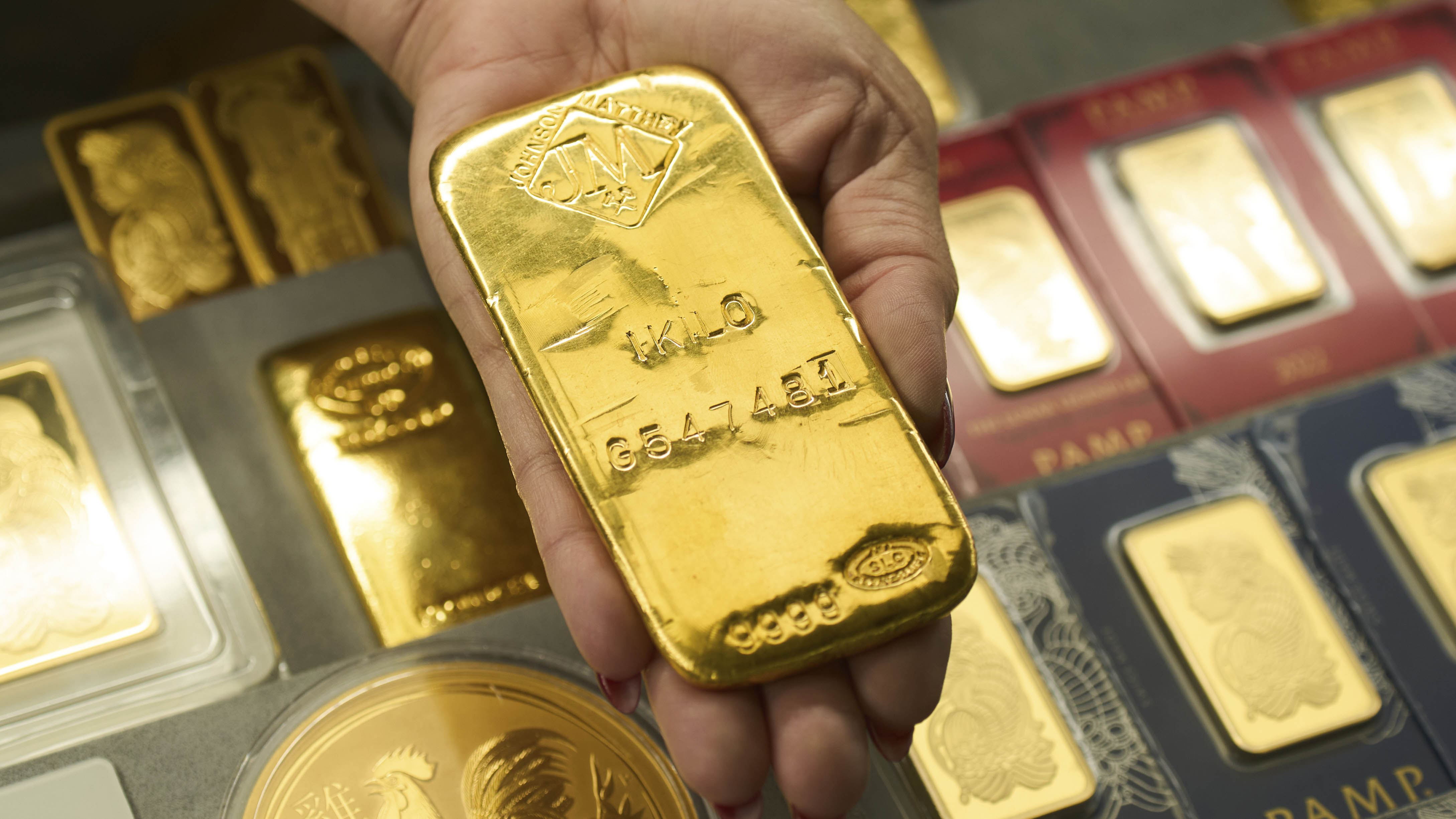Soaring Gold Prices: US Jewelry Merchants' Hidden Boom!
Gold Rush 2.0: Economic Fears Fuel Jewelry Frenzy in the US
Introduction: A Golden Opportunity or a Sign of the Times?
Have you ever felt that nagging unease about the economy? The kind that makes you double-check your bank balance and maybe even consider stashing some cash under your mattress? You're not alone. As global economic jitters send shockwaves through financial markets, one precious metal is shining brighter than ever: gold. And that shine is creating a frenzy for US jewelry merchants.
At the heart of this gold rush is a place like St. Vincent Jewelry Center in downtown Los Angeles, a glittering hub where fortunes are literally melted down and reshaped. Imagine Alberto Hernandez, firing up his machine, the orange glow reflecting in his eyes as he prepares to transform a collection of jewelry into pure gold. He's not just melting metal; he's melting down economic anxieties into a tangible asset.
Minutes later, the bubbling liquid cools, and an X-ray reveals its worth: $177,000 based on that day's gold price. That's just one batch. One small snapshot of the sheer volume of gold circulating through the center. But why this sudden surge? Let's dive deeper.
The Midas Touch: Gold's Enduring Appeal
Why is gold always the answer? The allure of gold isn't new. It's been a symbol of wealth and status for millennia. But in times of economic uncertainty, it becomes more than just a pretty metal; it becomes a safe haven, a store of value that tends to hold its worth, or even increase, when other assets are floundering. Think of it as the economic equivalent of a warm blanket on a cold night.
A Hedge Against Inflation
One of the primary drivers behind the gold rush is inflation. As the cost of goods and services rises, people look for ways to protect their purchasing power. Gold, unlike paper currency, can't be printed into oblivion. Its limited supply makes it a valuable hedge against inflation.
Uncertainty Breeds Opportunity
Global political and economic instability can send investors scurrying for safety. Wars, pandemics, and even just the general feeling of unease can trigger a flight to gold. It's a tangible asset that transcends borders and political turmoil. After all, even if your local currency is worthless, gold will always be gold.
St. Vincent Jewelry Center: Ground Zero for the Gold Boom
St. Vincent Jewelry Center, with its 500 independent tenants, is a microcosm of the national trend. Jewelers, gold refiners, and assayers are experiencing a surge in business unlike anything they've seen before. It's a bustling marketplace where old jewelry gets a new lease on life, and economic anxieties are transformed into gleaming bars of gold.
A Diverse Clientele
Who's driving this demand? It's not just the wealthy elite. It's everyday people looking to diversify their investments and protect their savings. The center also attracts a diverse clientele, from rappers looking to melt down their bling to average citizens selling inherited jewelry.
The Recycling Revolution
This isn't just about buying new gold; it's about recycling. Old jewelry, broken chains, even dental fillings are finding their way into the melting pots of St. Vincent. It's a testament to the enduring value of gold and its ability to be repurposed and reused.
Beyond the Bling: The Economic Impact
The gold frenzy isn't just good news for jewelry merchants. It has broader economic implications. The increased demand for gold creates jobs, stimulates local economies, and contributes to the overall financial health of the nation.
Job Creation
From miners extracting gold from the earth to refiners purifying it to jewelers crafting it into new pieces, the gold industry supports a vast network of jobs. The current boom is likely to create even more opportunities in these sectors.
A Boost for Small Businesses
Many of the businesses at St. Vincent Jewelry Center are small, independent operations. The surge in demand is providing a much-needed boost to these businesses, allowing them to thrive in challenging economic times.
Navigating the Gold Market: Tips for Buyers and Sellers
If you're considering buying or selling gold, it's crucial to do your research and proceed with caution. The gold market can be volatile, and it's important to understand the risks involved.
For Sellers: Know Your Gold
Before you sell, get your jewelry appraised by a reputable appraiser. Knowing the karat and weight of your gold will help you negotiate a fair price. Don't be afraid to shop around and get multiple quotes.
For Buyers: Do Your Due Diligence
Buy from reputable dealers and always insist on a certificate of authenticity. Be wary of deals that seem too good to be true. Remember, gold is an investment, so treat it like one.
The Future of Gold: Will the Rally Continue?
Predicting the future of the gold market is a tricky business. However, several factors suggest that the rally could continue in the near term.
Geopolitical Tensions
As long as geopolitical tensions remain high, investors are likely to continue flocking to gold as a safe haven asset.
Inflationary Pressures
If inflation persists, gold could continue to outperform other asset classes.
Central Bank Policies
Changes in central bank policies, such as interest rate hikes or quantitative easing, could also impact the price of gold.
Challenges and Concerns
The gold boom isn't without its challenges. Increased demand can lead to price volatility, and there are ethical concerns surrounding gold mining practices.
Price Volatility
The price of gold can fluctuate wildly, making it a risky investment for those with a short-term outlook. It's important to be prepared for potential dips in the market.
Ethical Sourcing
Consumers are increasingly concerned about the ethical sourcing of gold. It's important to buy from companies that are committed to responsible mining practices and fair labor standards.
The Social Impact: More Than Just Money
The surge in gold prices has a social impact, influencing perceptions of wealth, security, and even status.
Changing Perceptions of Value
As gold becomes more valuable, it reinforces its status as a symbol of wealth and security. This can lead to increased demand and further price increases.
A Sense of Security
For some, owning gold provides a sense of security in uncertain times. It's a tangible asset that they can hold onto, knowing that it will likely retain its value.
The Role of Technology
Technology plays a significant role in the gold trade, from the X-ray machines used to analyze gold purity to the online platforms that facilitate buying and selling.
Assaying and Refining
Advanced technologies allow for more accurate and efficient assaying and refining of gold, ensuring its purity and value.
Online Trading Platforms
Online platforms make it easier for individuals to buy and sell gold, increasing accessibility to the market.
The Psychology of Gold
The human fascination with gold runs deep. It's a primal attraction that taps into our subconscious desires for wealth, power, and security.
A Symbol of Power
Throughout history, gold has been associated with power and royalty. Owning gold can evoke feelings of status and control.
An Escape from Anxiety
In times of uncertainty, gold can provide a sense of calm and security. It's a tangible asset that can help alleviate financial anxieties.
Conclusion: Is Gold the Answer to Economic Woes?
So, is the gold rush a sign of economic doom and gloom, or a golden opportunity for investors and jewelry merchants alike? The answer, as always, is complex. While soaring gold prices may reflect underlying economic anxieties, they also present opportunities for those who are willing to navigate the market with caution and informed decision-making. Whether you're melting down old jewelry or investing in gold bullion, remember to do your research and understand the risks involved. After all, even the shiniest metal can tarnish if handled carelessly.
Frequently Asked Questions (FAQs)
- Q: Why are gold prices rising right now?
A: Several factors contribute to rising gold prices, including economic uncertainty, inflation, geopolitical tensions, and increased demand from investors seeking a safe haven asset.
- Q: Is it a good time to sell my gold jewelry?
A: With gold prices at record highs, it could be an opportune time to sell unwanted gold jewelry. However, get your jewelry appraised and compare offers from multiple buyers to ensure you're getting a fair price.
- Q: How can I invest in gold?
A: There are several ways to invest in gold, including buying physical gold (bullion, coins, jewelry), investing in gold ETFs (exchange-traded funds), or purchasing shares in gold mining companies.
- Q: What are the risks of investing in gold?
A: The main risks of investing in gold include price volatility, storage costs (for physical gold), and the potential for fraud when dealing with unfamiliar dealers.
- Q: Where can I find a reputable gold buyer?
A: Look for gold buyers with a solid reputation, positive online reviews, and transparent pricing policies. Check if they are members of industry organizations or have any certifications. Ask for referrals from trusted sources.

